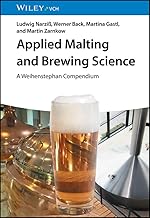
Book
Applied Malting and Brewing Science : A Weihenstephan Compendium
ISBN : 9783527347346
Author : Ludwig Narziß
Publisher : Wiley
Year : 2023
Language : English
Type : Book
Description : Table of Contents A Few Words of Thanks ix Preface xi 1 The Technology of Malting 1 1.1 Malting Barley 1 1.1.1 The Morphology of Barley 2 1.1.2 The Chemical Composition of Barley 2 1.1.3 Determining and Evaluating the Properties of Barley 6 1.2 Preparing Barley for Malting 9 1.2.1 Receiving Barley in Bulk 9 1.2.2 Conveyor Systems 9 1.2.3 Cleaning and Sorting Barley 10 1.2.4 Preparing and Storing Barley 13 1.2.5 Artificial Drying of Barley 16 1.2.6 Plant Diseases and Animal Pests Affecting Barley 18 1.2.7 Changes in the Weight of Barley During Storage 19 1.3 Steeping the Barley 19 1.3.1 Moisture Uptake in the Barley Kernel 19 1.3.2 Supplying Oxygen to the Steeping Grain 20 1.3.3 Cleaning the Barley 21 1.3.4 Water Consumption 21 1.3.5 Steeping Equipment 22 1.3.6 Steeping Technology 25 1.4 Germination 28 1.4.1 The Theory of Germination 28 1.4.2 The Practice of Germination 36 1.5 Various Malting Systems 41 1.5.1 Floor Malting 41 1.5.2 Pneumatic Malting Systems 45 1.5.3 Germination Vessels in Pneumatic Malting Systems 49 1.5.4 The Finished Green Malt 65 1.6 Kilning the Green Malt 66 1.6.1 The Processes Involved in Kilning 66 1.6.2 Kilns 72 1.6.3 Kilning Techniques 79 1.6.4 Monitoring and Automating Kilning – Kiln Maintenance 87 1.6.5 Energy-Saving Measures 88 1.6.6 Additional Tasks Associated with Kilning 89 1.6.7 Handling of Malt After Kilning 90 1.6.8 Storing Malt and Maintaining Malt Stores 91 1.7 Malting Losses 92 1.7.1 Losses During Steeping 93 1.7.2 Losses During Respiration and Germination 93 1.7.3 Calculating Malting Losses 94 1.8 The Properties of Malt 95 1.8.1 External Characteristics 95 1.8.2 Mechanical Analysis 95 1.8.3 Physico-Chemical Analysis 96 1.9 Malt from Other Grains 98 1.9.1 Wheat Malt 98 1.9.2 Malt from Alternative Cereals 100 1.9.3 Pseudocereals 103 1.9.4 Specialty Malts 103 1.9.5 Micromalting 106 2 The Technology of Wort Production 109 2.1 Raw Materials for the Brewing Process 109 2.1.1 Malt 109 2.1.2 Adjuncts: Alternatives to Malt 109 2.1.3 Brewing Liquor 111 2.1.4 Hops 124 2.1.5 Adding Hops to the Wort 139 2.2 Milling the Malt 148 2.2.1 Monitoring Grist Quality 150 2.2.2 Mill Designs 150 2.2.3 Properties and Composition of the Grist 158 2.2.4 The Arrangement of the Milling Area 159 2.3 Wort Production 159 2.3.1 The Theory of Mashing 159 2.3.2 Mashing Techniques 168 2.3.3 Mashing Regimes 174 2.3.4 Particular Issues with Mashing 185 2.3.5 Monitoring the Mashing Process 186 2.4 Extracting the Wort (Lautering) 188 2.4.1 Operations During Lautering 188 2.4.2 The Lauter Tun 189 2.4.3 The Lautering Process with a Lauter Tun 192 2.4.4 Lautering with a Conventional Mash Filter 202 2.4.5 Membrane Compression Filters 203 2.4.6 The Thin-bed Filter 205 2.4.7 A Comparison of Thin-bed Mash Filtration and the Modern Lauter Tun 207 2.4.8 The Strainmaster 207 2.4.9 Continuous Lautering Methods 208 2.4.10 The Wort Collection Vessel 209 2.5 Boiling and Hopping the Wort 209 2.5.1 Wort Kettles 210 2.5.2 Physical Processes During Wort Boiling 215 2.5.3 Coagulation of Protein 216 2.5.4 Hopping the Wort 219 2.5.5 Aroma Compounds in Wort 226 2.5.6 Technical and Energy Aspects of Modern Wort Boiling Systems 229 2.5.7 Casting Out the Wort 236 2.5.8 The Cast-out Wort 237 2.5.9 Cleaning the Brewhouse Equipment 237 2.5.10 Automating the Wort Boiling Process 239 2.5.11 Options for Recovering Residual Extract 239 2.5.12 Spent Grain 241 2.5.13 Safety and Consistency in the Brewhouse Production 241 2.6 Brewhouse Yield 242 2.6.1 Calculation of Brewhouse Yield 242 2.6.2 Assessing Brewhouse Yield 244 2.6.3 Conclusions on the Topic of Brewhouse Yield 246 2.7 Wort Chilling and Elimination of Break Material 246 2.7.1 Chilling the Wort 247 2.7.2 Oxygen Uptake in the Wort 247 2.7.3 Elimination of Hot and Cold Break Material 247 2.7.4 Other Processes 249 2.7.5 Wort Chilling and Cold Wort Handling 249 2.7.6 Operations with a Coolship and a Baudelot (Falling Film) Chiller or a Closed Chiller 249 2.7.7 Closed Wort Chilling Systems 251 2.8 Cold Wort Yield 260 2.8.1 Data Collected for Cold Wort Yield 260 2.8.2 Calculation of Cold Wort Yield 260 2.8.3 Overall Yield in Wort Production (Overall Brewhouse Yield – OBY) 261 3 The Technology of Fermentation 263 3.1 Brewing Yeast 263 3.1.1 Yeast Morphology 263 3.1.2 The Chemical Composition of Yeast 264 3.1.3 Yeast Enzymes 264 3.1.4 Yeast Reproduction 265 3.1.5 Yeast Genetics 266 3.1.6 Genetic Manipulation of Yeast 266 3.1.7 Yeast Autolysis 268 3.2 Yeast Metabolism 268 3.2.1 Carbohydrate Metabolism 269 3.2.2 Protein Metabolism 271 3.2.3 Lipid Metabolism 272 3.2.4 Mineral Metabolism 273 3.2.5 Vitamins 274 3.2.6 Metabolites and Their Significance for Beer Quality 274 3.3 Bottom-fermenting Yeast in Brewing Operations 279 3.3.1 Yeast Strain Selection 279 3.3.2 Culturing Pure Strains of Brewing Yeasts 279 3.3.3 Yeast Degeneration and Loss of Typical Characteristics 281 3.3.4 Harvesting Yeast 282 3.3.5 Cleaning the Yeast 283 3.3.6 Yeast Storage 284 3.3.7 Shipping Yeast – Dry Yeast 285 3.3.8 The Physiological Condition of the Yeast 285 3.4 Beer Production with Bottom-fermenting Yeast 286 3.4.1 Fermentation Rooms or Cellars 286 3.4.2 Fermentation Vessels 287 3.4.3 Pitching the Yeast 294 3.4.4 Conducting Fermentation 297 3.4.5 Primary Fermentation 298 3.4.6 Degree of Attenuation 301 3.4.7 Maturation Levels of the Green Beer 304 3.4.8 Changes in the Wort During Fermentation 304 3.4.9 Recovery of Carbon Dioxide Produced During Fermentation 307 3.5 Maturation and Lagering 309 3.5.1 The Lager Cellar 310 3.5.2 Lager Vessels 311 3.5.3 The Maturation Process 312 3.6 Modern Fermentation and Lagering Methods in Beer Production 321 3.6.1 Methods of Operation for Fermenting in Tanks and Larger Vessels 321 3.6.2 Utilization of Intermediate Storage Tanks and Implementation of a Green Beer Centrifuge 326 3.6.3 Methods for Accelerating Fermentation and Maturation 327 3.6.4 Continuous Fermentation Processes 335 3.6.5 Classic CCTs Employed in a Continuous-flow Process 336 3.6.6 Hopping Beer on the Cold Side 336 4 Beer Filtration 339 4.1 The Theory of Filtration 339 4.2 Filtration Technology 341 4.2.1 Pulp Filtration 341 4.2.2 Diatomaceous Earth Filtration 342 4.2.3 Sheet Filters 349 4.2.4 Membrane Filtration 350 4.2.5 Centrifuges 351 4.3 Combined Clarification Processes 353 4.4 Options for Replacing Diatomaceous Earth as a Filter Medium 353 4.4.1 Combining a Centrifuge with a Pulp Filter 353 4.4.2 Combining a Fine Clarification Centrifuge and a Horizontal Filter 354 4.4.3 Multi-step Microfiltration 354 4.4.4 Filter Sheets 354 4.4.5 The Use of Synthetic Extrudates 355 4.4.6 Crossflow Microfiltration 355 4.4.7 Concluding Remarks on Modern Filtration Systems 359 4.5 Filtration – Auxiliary Equipment and Monitoring Devices 359 4.5.1 Auxiliary Equipment 360 4.5.2 Devices for Monitoring Filtration 360 4.6 Beginning and Ending a Filtration Run 361 4.7 Tank Bottoms 362 4.8 Compressed Air 363 5 Packaging Beer 365 5.1 Beer Storage After Filtration 365 5.2 Filling Barrels and Casks 365 5.2.1 Barrels and Casks 365 5.2.2 Cleaning Barrels and Casks 366 5.2.3 Filling Casks and Barrels 367 5.2.4 Improvements in Filling and Dispensing from Conventional Casks 368 5.2.5 Cleaning and Filling Kegs 368 5.2.6 Filling and Storage Areas 371 5.3 Bottling and Canning 371 5.3.1 The Containers 371 5.3.2 Cleaning Bottles 374 5.3.3 Bottling 377 5.3.4 Cleaning and “Sterilizing” Filling Machines 382 5.3.5 Capping the Bottles 383 5.3.6 Oxygen Uptake During Bottling 383 5.4 “Sterile Filling” and the Pasteurization of Beer 387 5.4.1 “Sterile Filling” 387 5.4.2 Pasteurization of Beer 391 5.5 The Layout of a Bottling Plant 393 6 Beer Losses 395 6.1 Factors Affecting Beer Losses 395 6.1.1 Wort Losses 396 6.1.2 True Beer Losses 397 6.2 Calculating Beer Losses 399 6.2.1 Calculation of Volumetric Losses 399 6.2.2 Calculation of Surpluses and Deficits 400 6.2.3 Calculating the Quantity of Wort and Beer Obtained from 100 kg of Malt 400 6.2.4 Calculating the Extract Losses from the Cast-out Wort and/or from Malt Grist 400 6.2.5 The Economic Aspects of Recovering Beer 401 7 The Finished Beer 405 7.1 The Composition of Beer 405 7.1.1 Extract in Beer 405 7.1.2 Volatile Compounds 406 7.2 The Classification of Beer 407 7.3 Properties of Beer 407 7.3.1 General Characteristics 407 7.3.2 The Redox Potential of Beer 407 7.3.3 Beer Color 408 7.4 The Aroma of Beer 408 7.4.1 Characteristics of Beer Aroma 409 7.4.2 Factors Influencing Flavor 410 7.4.3 Off-flavors in Beer 411 7.5 Beer Foam 414 7.5.1 The Theory of Foam Formation 414 7.5.2 Technological Influences on the Properties of Beer Foam 415 7.6 Factors Affecting the Physico-chemical Properties of Beer and Their Stabilization 418 7.6.1 The Composition of Colloidal Turbidity 418 7.6.2 The Formation of Colloidal Turbidity 419 7.6.3 Technological Measures to Improve Colloidal Stability 419 7.6.4 The Stabilization of Beer 419 7.6.5 The Flavor Stability of Beer 428 7.6.6 Methods for Monitoring and Predicting Flavor Stability 434 7.6.7 Turbidity Originating Chemically 435 7.6.8 Gushing 436 7.7 Filterability of Beer 438 7.7.1 The Causes of Poor Filterability in Beer 438 7.7.2 Remedial Measures 440 7.8 Microbiological Stability of Beer 441 7.8.1 Sources of Contamination 441 7.8.2 Maintaining Microbiological Shelf Life 443 7.9 Physiological Effects of Beer 445 7.9.1 The Nutritional Value of Beer 445 7.9.2 Dietary Effects of Beer 446 7.10 Bottom-fermented German Beer Styles 446 7.10.1 Pale Lager Beer (Helles) 447 7.10.2 Pale Export (12.5+ %, w/w) 447 7.10.3 Pils or Pilsner 448 7.10.4 Heller Bock 448 7.10.5 Märzen 449 7.10.6 Dunkles and Schwarzbier 449 7.10.7 German Porter 450 7.10.8 Rauchbier or Smoked Beer 450 7.11 Special Beers 451 7.11.1 Dietetic Beers of the Past 451 7.11.2 Nutritive Beers 453 7.11.3 Non-alcoholic Beers 454 7.11.4 Methods for Limiting Alcohol Content 454 7.11.5 Alcohol Removal with Physical Methods 456 7.11.6 Combinations of Different Processes in the Production of Non-alcoholic Beer 459 7.11.7 Low-alcohol Beers 461 8 Top Fermentation 465 8.1 General Information 465 8.2 Top-fermenting Yeast 465 8.2.1 Morphological Characteristics 465 8.2.2 Physiological Differences 466 8.2.3 Fermentation Attributes 466 8.2.4 Yeast Handling 467 8.3 Top Fermentation Techniques 468 8.3.1 Fermentation Rooms and Fermentation Vessels 468 8.3.2 Wort Composition 470 8.3.3 Pitching the Yeast 470 8.3.4 Primary Fermentation 470 8.3.5 Changes in Wort During Top Fermentation 473 8.3.6 Maturation 474 8.3.7 Filtration and Filling 476 8.4 Production Methods for Various Top-fermented German Beers 477 8.4.1 Altbier (Düsseldorf and Lower Rhine) 477 8.4.2 Kölsch 479 8.4.3 Kristallweizen – Filtered Wheat Beer (Free of Yeast) 480 8.4.4 Hefeweizen – Bavarian-style Wheat Beer with Yeast 484 8.4.5 Top-fermented Beers Brewed with Malted Cereals Other Than Barley and Wheat 488 8.4.6 Berliner Weisse 490 8.4.7 Other Traditional Top-fermented Beer Styles 491 8.4.8 Malzbier 493 8.4.9 Bavarian-style, Top-fermented Nutritive Beers 493 8.4.10 Top-fermented, Non-alcoholic Beers 494 8.4.11 Top-fermented, Low-alcohol Beers 494 8.5 Gluten-Free Beer 494 8.5.1 Production from Conventional Raw Materials – Genetic Modification of Raw Materials Through Breeding 494 8.5.2 Enzymatic Modification of Raw Materials 494 8.5.3 Beer Production from Gluten-free Sugar or Starch Sources 495 8.5.4 Carbohydrate-rich Cereals and Pseudocereals 495 9 High-gravity Brewing 497 9.1 High-gravity Wort Production 497 9.1.1 Lautering 497 9.1.2 Mashing 497 9.1.3 Wort Boiling 497 9.1.4 Whirlpool Operations 498 9.1.5 Dilution of High-gravity Wort at the Chiller 498 9.2 Fermentation of High-gravity Wort 499 9.3 Dilution of High-gravity Beer After Maturation 499 9.4 The Properties of Beer Produced with High-gravity Techniques 500 Index 501








